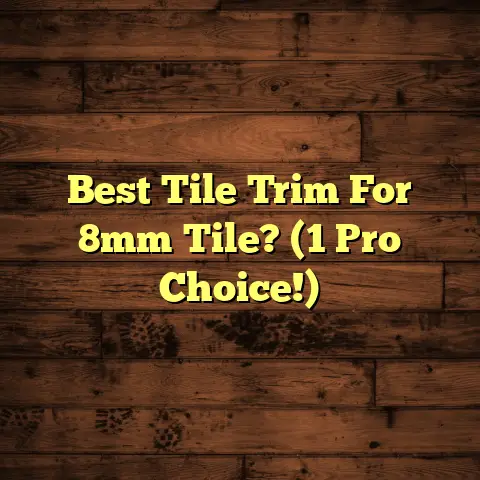Fix Worn Wood Floors Fast! (6 DIY Tips)
Ever walk into a room and feel like the floor is telling a story?
I’m talking about wood floors.
They’re beautiful, warm, and full of character.
But let’s be honest, they can also show their age.
Think of those faded spots where the sun hits just right, or the little dings from years of family life.
Visual Imagery:
Imagine sunlight streaming through your window, highlighting every scratch and imperfection on your once-pristine wood floor.
You see the contrast between the rich grain and the worn patches, a testament to time.
Tactile Sensation:
Now, feel the floor under your feet.
In some places, it’s smooth and cool, in others, rough and uneven.
Maybe you even feel a slight chill during those colder months.
Auditory Elements:
Listen closely as you walk across the room.
Do you hear the gentle creaks and groans that tell tales of countless footsteps?
It’s a familiar sound, a comforting reminder of the life that’s been lived within those walls.
Emotional Connection:
For me, these floors aren’t just surfaces; they’re part of my home’s history.
They hold memories of laughter, tears, and everything in between.
But sometimes, they just need a little TLC to bring back their former glory.
That’s why I’m sharing my top 6 DIY tips to fix worn wood floors fast!
Section 1: Assessing the Damage
Alright, before we dive in, let’s take a good look at what we’re dealing with.
Think of it like a doctor’s visit for your floors.
First, you need to figure out what kind of wear you’re seeing.
Are we talking about minor scratches, or something deeper like gouges or discoloration?
Types of Wear:
-
Minor Scratches: These are usually surface-level and often caused by pets, furniture, or everyday foot traffic.
-
Deeper Gouges: These are more significant and can be caused by dropped objects or heavy impact.
-
Discoloration: This can be due to sun exposure, water damage, or just the natural aging process of the wood.
Now, here’s a crucial question: Is your floor solid hardwood or engineered wood?
This makes a HUGE difference in how you approach repairs.
Solid Hardwood:
This is the real deal – planks made from a single piece of wood.
These floors can be sanded down and refinished multiple times, making them very durable.
Engineered Wood:
This consists of a thin layer of real wood bonded to a core of plywood or fiberboard.
You can usually only sand these down once or twice, so you need to be more careful with repairs.
How to Tell the Difference:
The easiest way is to look at the edges of the planks.
If you see distinct layers, it’s likely engineered wood.
If it looks like solid wood all the way through, you’ve probably got hardwood.
Moisture Damage:
Finally, check for any signs of moisture damage or warping.
This could indicate a more serious problem that needs professional attention.
Look for:
-
Cupping: Where the edges of the planks are higher than the center.
-
Crowning: Where the center of the planks is higher than the edges.
-
Dark Stains: These can indicate mold or mildew growth.
According to the National Wood Flooring Association (NWFA), moisture is the biggest enemy of wood floors.
They recommend maintaining a consistent humidity level in your home to prevent damage.
Once you’ve assessed the damage, you’ll have a much better idea of what kind of repairs you need to tackle.
Section 2: Gather Your Tools and Materials
Okay, now that we know what we’re up against, let’s get our toolbox ready!
I always say, having the right tools is half the battle.
And don’t worry, you don’t need to be a pro to do this.
I’m going to focus on tools and materials that are easy to find and use for the average homeowner.
Essential Tools:
-
Sandpaper: You’ll need a variety of grits, from coarse (80-grit) to fine (220-grit), depending on the severity of the damage.
-
Sanding Block or Orbital Sander: A sanding block is great for small areas, while an orbital sander is faster for larger surfaces.
-
Wood Filler: Choose a color that matches your floor as closely as possible.
-
Putty Knife: For applying wood filler smoothly.
-
Stain: Again, match the color to your existing floor. You might want to test it in an inconspicuous area first.
-
Sealant (Polyurethane): This protects the wood and gives it a nice finish. Choose between oil-based or water-based, depending on your preference. Oil-based is more durable but has a stronger odor.
-
Clean Rags: For wiping up dust and applying stain/sealant.
-
Painter’s Tape: To protect surrounding areas.
-
Safety Glasses and Dust Mask: Always protect your eyes and lungs when sanding or working with chemicals.
Product Recommendations:
-
Wood Filler: I’ve had good luck with Minwax Wood Filler. It’s easy to work with and dries quickly.
-
Stain: Varathane is a reliable brand with a wide range of colors.
-
Polyurethane: For durability, I recommend Rust-Oleum Ultimate Polyurethane.
Safety First:
Before you start any DIY project, make sure you understand how to use each tool safely.
Read the instructions carefully and wear appropriate safety gear.
According to the Consumer Product Safety Commission (CPSC), thousands of injuries occur each year due to improper tool use.
So, take your time and be careful!
Once you’ve gathered all your tools and materials, you’re ready to start fixing those floors!
Section 3: Quick Fixes for Minor Scratches
Alright, let’s start with the easy stuff.
Minor scratches are usually the most common issue and can be fixed with some simple tricks.
Wood Markers or Crayons:
These are basically colored pencils for wood.
You can find them in a variety of colors to match your floor.
How to Use:
-
Clean the scratched area with a damp cloth.
-
Select a marker or crayon that closely matches the color of your floor.
-
Gently color in the scratch, applying light pressure.
-
Wipe away any excess with a clean rag.
-
Let it dry completely.
Vinegar and Olive Oil:
This is an old-school trick that works surprisingly well on minor surface scuffs.
The vinegar helps to clean the wood, while the olive oil moisturizes and adds shine.
How to Use:
-
Mix equal parts vinegar and olive oil in a small bowl.
-
Dip a clean rag into the mixture and wring out any excess.
-
Gently rub the mixture onto the scratched area in a circular motion.
-
Buff the area with a clean, dry cloth until the scratch disappears.
Fine Abrasive Pad:
For slightly deeper scratches, you can try buffing them out with a fine abrasive pad (like a Scotch-Brite pad).
How to Use:
-
Clean the scratched area with a damp cloth.
-
Lightly dampen the abrasive pad with water.
-
Gently buff the scratch in the direction of the grain.
-
Wipe away any residue with a clean rag.
-
Apply a small amount of wood polish to restore shine.
These quick fixes are great for hiding minor imperfections and making your floors look instantly better.
Section 4: Repairing Deeper Gouges
Okay, now let’s tackle those more serious gouges.
This requires a bit more effort, but it’s still something you can do yourself.
Wood Filler:
Wood filler is your best friend when it comes to repairing deeper damage.
It fills in the gouge and creates a smooth surface that you can then stain and seal.
Choosing the Right Wood Filler:
-
Color: Try to find a wood filler that closely matches the color of your floor. You can also mix different colors together to get the perfect match.
-
Type: There are different types of wood filler, including water-based and solvent-based. Water-based is easier to clean up, while solvent-based is more durable.
Applying Wood Filler:
-
Clean the gouged area thoroughly, removing any loose debris.
-
Apply the wood filler with a putty knife, overfilling the gouge slightly.
-
Let the filler dry completely, according to the manufacturer’s instructions. This usually takes several hours or even overnight.
-
Sand the dried filler with progressively finer grits of sandpaper (80-grit, 120-grit, 220-grit) until it’s flush with the surrounding surface.
Staining and Sealing:
-
Once the filler is sanded smooth, clean the area with a tack cloth to remove any dust.
-
Apply a stain that matches your floor, using a clean rag or brush. Let it dry completely.
-
Apply a coat of polyurethane sealant to protect the repair and blend it with the surrounding finish. Let it dry completely.
-
Apply a second coat of sealant for added protection.
Pro Tip:
When sanding the wood filler, use a sanding block to keep the surface flat and prevent you from sanding down the surrounding wood.
Section 5: Refreshing the Finish
Sometimes, your floors just need a little pick-me-up.
Refreshing the finish can make a huge difference in the overall appearance, without the need for a complete sanding and refinishing.
Cleaning the Floors:
Before you apply a new finish, you need to clean the floors thoroughly.
This removes any dirt, dust, and grime that could prevent the finish from adhering properly.
How to Clean:
-
Sweep or vacuum the floors to remove loose debris.
-
Mop the floors with a wood floor cleaner, following the manufacturer’s instructions.
-
Rinse the floors with clean water and dry them thoroughly.
Prepping for a New Finish:
Once the floors are clean, you need to prepare them for the new finish.
This involves lightly sanding the surface to create a better bond.
How to Prep:
-
Use a fine-grit sandpaper (220-grit) to lightly sand the floors.
-
Vacuum up any dust and wipe the floors with a tack cloth.
Applying a New Coat of Polyurethane:
-
Choose a polyurethane finish that’s compatible with your existing finish.
-
Apply the finish with a brush, roller, or applicator pad, following the manufacturer’s instructions.
-
Apply thin, even coats, working in the direction of the grain.
-
Let each coat dry completely before applying the next.
Buffing and Polishing:
After the new finish has dried, you can buff and polish the floors to enhance the shine.
How to Buff and Polish:
-
Use a floor buffer with a polishing pad to buff the floors.
-
Apply a wood floor polish and buff it in until the floors are shiny.
Refreshing the finish is a great way to rejuvenate your worn wood floors and make them look like new again.
Section 6: Preventative Maintenance Tips
Okay, you’ve fixed your floors, now let’s keep them looking great for years to come!
Preventative maintenance is key to extending the life and beauty of your wood floors.
Regular Cleaning Routines:
-
Sweep or vacuum your floors regularly to remove dirt and debris.
-
Mop your floors with a wood floor cleaner at least once a week.
-
Avoid using harsh chemicals or abrasive cleaners, as they can damage the finish.
Protecting Floors from Future Damage:
-
Use area rugs in high-traffic areas to protect the floors from wear and tear.
-
Place felt pads under furniture legs to prevent scratches and dents.
-
Avoid wearing shoes with high heels or cleats on your wood floors.
-
Trim your pets’ nails regularly to prevent scratches.
Regulating Humidity Levels:
-
Maintain a consistent humidity level in your home (between 30% and 50%) to prevent warping and cracking.
-
Use a humidifier or dehumidifier as needed to control humidity levels.
According to the Forest Products Laboratory, wood expands and contracts with changes in humidity, which can lead to damage over time.
Be Proactive:
-
Inspect your floors regularly for any signs of damage and address them promptly.
-
Reapply a coat of polyurethane sealant every few years to protect the finish.
By following these preventative maintenance tips, you can keep your wood floors looking beautiful for many years to come.
Conclusion
So, there you have it – my top 6 DIY tips for fixing worn wood floors fast!
I know, it might seem like a lot of work, but trust me, it’s worth it.
There’s nothing quite like the feeling of walking on a beautifully restored wood floor.
It brings warmth, character, and a sense of pride to your home.
Remember those faded spots, scratches, and imperfections we talked about earlier?
With a little effort and the right techniques, you can transform those worn areas into cherished parts of your home’s story.
Wood floors aren’t just surfaces; they’re a connection to the past, a foundation for the present, and a legacy for the future.
So, go ahead, give your floors the love and attention they deserve.
You’ll be amazed at the difference it makes!





